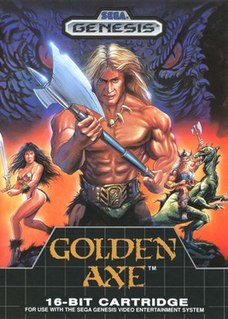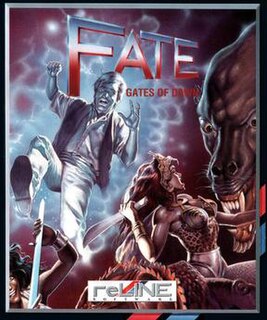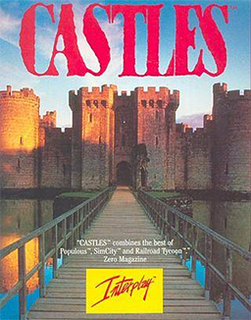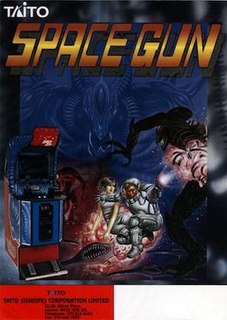
Ghouls 'n Ghosts, known as Daimakaimura in Japan, is a side-scrolling platform game developed by Capcom, released as an arcade game in 1988 and subsequently ported to a number of home platforms. It is the sequel to Ghosts 'n Goblins and the second game in the Ghosts 'n Goblins series.

Alien Breed is a shooter video game, the first in the Alien Breed series. It is played with a top-down view, for one or two players. It was released in 1991 by Team17 for the Commodore Amiga and later in 1993 by MicroLeague for MS-DOS.

Sensible Soccer, often called Sensi, is a association football video game series which was highly popular in the early 1990s and which still retains a cult following. It was developed by Sensible Software and first released for Amiga and Atari ST computers in 1992 as well as for the PC. The series was created by Jon Hare and Chris Yates, as a successor to their previous football game MicroProse Soccer (1988), which in turn was inspired by the arcade video game Tehkan World Cup (1985).

Paperboy is an arcade action game developed and published by Atari Games and Midway Games, and released in 1985. The player takes the role of a paperboy who delivers a fictional newspaper called The Daily Sun along a suburban street on his bicycle. The arcade version of the game featured bike handlebars as the controller.

Ghosts 'n Goblins, known as Makaimura in Japan, is a side-scrolling platform game developed by Capcom and released for arcades in 1985. It is the first game in the Ghosts 'n Goblins franchise, and has since been ported to numerous home platforms.

Golden Axe is a side-scrolling hack-and-slash video game released by Sega for arcades in 1989, running on the Sega System 16-B arcade hardware. Makoto Uchida was the lead designer of the game, and was also responsible for the creation of the previous year's Altered Beast. The game casts players as one of three warriors who must free the fantastical land of Yuria from the tyrannical rule of Death Adder, who wields the titular Golden Axe.

Dark Castle is a 1986 platform game for Macintosh published by Silicon Beach Software, later published by Three-Sixty Pacific for other platforms. It was designed and illustrated by Mark Pierce and programmed by Jonathan Gay. In Dark Castle, a young hero named Duncan tries to make his way to the evil Black Knight, dodging objects as well as solving occasional puzzles.

Crazy Sue Goes On, also known as Crazy Sue 2 and Crazy Sue II, is a 2D platform game for the Amiga which is the sequel to Crazy Sue, in which the player again takes the role of the little girl named Crazy Sue, and must defeat the wife of the evil Wizard of Doom whom she defeated in the first game.

Fate: Gates of Dawn is a role-playing video game released by reLINE Software in 1991 for the Commodore Amiga and in 1992 for the Atari ST.

Castles is a video game developed by Quicksilver and published by Interplay Entertainment in 1991 and 1992. The game involves the construction of a series of castles in Wales and the Welsh Marches during the 13th century. Castles was quickly followed by an expansion, Castles: The Northern Campaign, and a sequel, Castles II: Siege and Conquest.

Savage is an action video game developed by Probe Software and published by Firebird Software in 1988 for ZX Spectrum, Commodore 64, Amstrad CPC, Atari ST and MS-DOS. In 1989 Firebird published a version for the Amiga.

Gauntlet III: The Final Quest is a home computer game by U.S. Gold and Tengen it was released in 1991 for the Amiga, Atari ST, Commodore 64, ZX Spectrum, and Amstrad CPC. Besides the standard four main Gauntlet characters, Thor, Thyra, Merlin, and Questor, four new playable characters were available: Petras, a rock man; Dracolis, a lizard man; Blizzard, an ice man; and Neptune, a Merman. The game is viewed from an isometric perspective and the cooperative multiplayer mode only supports two-players.
Phillip Nixon is a British composer and graphic designer for video games. His most notable role was as a member of Flair Software during the 1990s, as an artist, musician and game designer. More recently, he had been part of Rage Software plc until the company went bust in 2003. Nixon has also had other roles working with Millennium Interactive, Hirographics and Horror Soft.

Space Gun is a 1990 first-person shooter arcade game released by Taito. The game is set aboard a crippled space station that has been overrun by hostile alien creatures. The objective is to rescue human crew members while destroying the alien creatures. The game lets the player shoot limbs off the creatures, resulting in blood splatters.

Elvira: Mistress of the Dark is a horror adventure/role-playing video game developed by Horror Soft and released by Accolade in 1990 for the Amiga, Atari ST, Commodore 64 and MS-DOS computers. It was Horror Soft's second published game after 1989's Personal Nightmare and stars the actress Cassandra Peterson as her character Elvira.

Ghosts 'n Goblins is a run and gun platform video game series created by Tokuro Fujiwara and developed by Capcom. The first entry in the series was Ghosts 'n Goblins, released in arcades on July 7, 1985. The series has subsequently been ported to and released on a variety of personal computers, game consoles and mobile platforms and spawned several sequels and spin-offs.

DarkSpyre is a 1990 computer game produced by Event Horizon Software for MS-DOS. It was released the following year for the Amiga. Darkspyre is a dungeon crawl style role-playing game. It uses top-down graphics and randomly generated dungeons, similar to a roguelike.

Line of Fire is a first-person perspective arcade light gun shooter game developed by Sega and released in 1989. The arcade cabinet features two positional guns, and a design which allows the player(s) to sit down while playing the game. It was first released in arcades in 1989 before being converted to home computers and published by U.S. Gold in 1990. It was released for the Master System in 1991; however, the style of the game was changed to that of an overhead scrolling shooter.

Flair Software was a British video game developer and publisher of the 1990s that developed and published games for the Amiga, Amiga CD32, Atari ST, Commodore 64, DOS, PlayStation, Sega Saturn and SNES. The developer is mainly associated with popular and colourful Amiga games as Elvira: The Arcade Game, Trolls, Oscar and Whizz. In 1993 platformer Oscar was bundled with Millennium's Diggers as launch bundle for the Amiga CD32 and it was considered one of the mascot games for the failed system. Flair Software's 1994 fighting game Dangerous Streets is generally considered one of the worst games of all time.

Dragon's Lair is an interactive film LaserDisc video game developed by Advanced Microcomputer Systems and published by Cinematronics in 1983, as the first game in the Dragon's Lair series. In the game, the protagonist Dirk the Daring is a knight attempting to rescue Princess Daphne from the evil dragon Singe who has locked the princess in the foul wizard Mordroc's castle. It featured animation by ex-Disney animator Don Bluth.



















